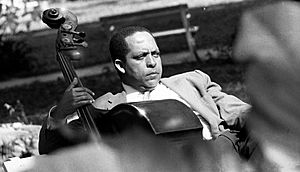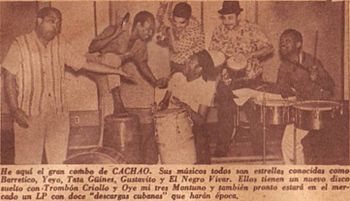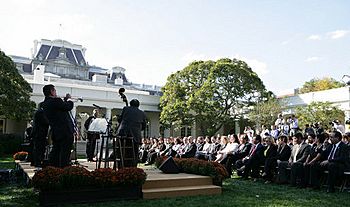Cachao facts for kids
Quick facts for kids
Cachao
|
|
|---|---|

Cachao in Havana, 1960.
|
|
| Background information | |
| Birth name | Israel López Valdés |
| Born | September 14, 1918 Habana Vieja, La Habana, Cuba |
| Died | March 22, 2008 (aged 89) Coral Gables, Florida, U.S. |
| Genres | Danzón, mambo, descarga |
| Occupation(s) | Musician, composer, bandleader |
| Instruments | Double bass |
| Years active | 1926–2008 |
| Labels | Panart, Kubaney, Maype, Salsoul, EMI |
| Associated acts | Orestes López, Arcaño y sus Maravillas, Andy García |
Israel López Valdés (born September 14, 1918 – died March 22, 2008), known to everyone as Cachao (pronounced kə-CHOW), was a famous Cuban musician. He played the double bass and wrote music. Cachao is especially known for helping to create a music style called mambo. He was also a master of the descarga, which are like exciting, unplanned music jams.
Throughout his long career, Cachao played and recorded many different kinds of music, from classical music to salsa. He moved to the United States in the 1960s. Even though he was famous in Cuba, he became known around the world mostly after his music career got a big boost in the 1990s.
Cachao was born into a family of musicians in Havana, Cuba. He and his older brother, Orestes López, were very important to a popular Cuban band called Arcaño y sus Maravillas. With this band, Cachao and Orestes helped create a new type of dance music called the danzón-mambo. This style later grew into the international music genre we know as mambo.
In the 1950s, Cachao became famous for making descargas popular. These were special, improvised (unplanned) music sessions. In 1962, he moved to Spain, and then to the United States in 1963. In New York, he worked as a musician for many different bands during the time when boogaloo and later salsa music became popular.
In the 1970s, Cachao was not as well-known after moving to Las Vegas and then Miami. He released new music only now and then. But in the 1990s, actor Andy García helped him become famous again. García made a documentary film and released several albums about Cachao. Before he passed away in 2008, Cachao received a star on the Hollywood Walk of Fame and won several Grammy Awards. He is considered one of the greatest bass players of all time.
Contents
Cachao's Life Story
Early Life and Music Beginnings
Cachao was born on September 14, 1918, in a neighborhood called Belén in Old Havana, Cuba. He came from a very musical family; about 40 or more people in his family played the bass! He was even born and grew up in the same house where Cuban hero José Martí was born. His grandfather, Aurelio López, gave him the nickname Cachao from a Spanish word meaning "banter" or "joking around."
Cachao started playing music in 1926 when he was just 8 years old. His father, Pedro López, and his older brother, Orestes López, who played many instruments, taught him. At first, Cachao played the bongo drums in a children's band. A year later, he switched to the double bass. He played music for silent movies in his local theater. He even played with a pianist who would become a big star, Ignacio Villa, also known as Bola de Nieve. This movie theater work stopped in 1930 when movies with sound (called talkies) came to Cuba.
His parents made sure he had classical music training. He learned at home and then at a music school. When he was a teenager, he was already playing the double bass with the Orquesta Filarmónica de La Habana (Havana Philharmonic Orchestra). His brother Orestes was one of the people who started this orchestra. Famous conductors like Herbert von Karajan and Igor Stravinsky led the orchestra while Cachao played. He stayed with the orchestra from 1930 to 1960.
The Maravillas Band and Mambo's Start
Cachao and Orestes became very famous with a band called Arcaño y sus Maravillas. This band was led by a flute player named Antonio Arcaño. As part of this group, Cachao and Orestes wrote thousands of danzones (a type of Cuban dance music). They had a huge impact on Cuban music from the 1930s to the 1950s.
In the late 1930s, they introduced a "new rhythm" called the nuevo ritmo. This changed the traditional danzón by adding an exciting, fast part at the end where musicians and dancers could improvise (make up music and dance moves on the spot). This new section was called the mambo. It was named after a danzón song called "Mambo," which Cachao and Orestes wrote together. Cachao said the word "mambo" came from a word meaning "story or tale" used by some African groups in Cuba. A Cuban writer once called it the "mother of all mambos."
The Maravillas band also played songs by other writers, like "Isora Club" by their sister Coralia López. They even played their own versions of popular songs like "Somewhere Over the Rainbow" and songs by George Gershwin. The Maravillas, also known as La Radiofónica, became very popular on the radio in the mid-1940s. They had their own radio show and grew to 14 musicians by 1944.
Cachao left the group in 1949 because he had to write so much music for each band member. He then joined the Blanquita Theater orchestra, which had 50 musicians and played in big stage shows. The Maravillas continued for another ten years. Their last big song, released in 1957, was "Chanchullo" (meaning "trick" or "scheme"), which Cachao himself helped create. This song became a hit in the United States because it was used as the basis for Tito Puente's famous song "Oye cómo va."
Jam Sessions at Panart Studios

One day in 1957, Cachao gathered a group of musicians very early in the morning (from 4 to 9 AM). They were full of energy from playing at Havana's popular nightclubs. They went to a recording studio to have a jam session. These unplanned music sessions, called descargas, changed Afro-Cuban popular music forever.
Under Cachao's leadership, these amazing musicians improvised freely, much like in jazz music. But they used the sounds and rhythms of Cuba's popular music. These descargas were released in 1957 by the Panart music company. The album was called Cuban Jam Sessions in Miniature. Many music experts say this is one of the most important Cuban records from the 1950s. It's even listed in a book called 1000 Recordings to Hear Before You Die.
Between 1957 and 1959, Cachao recorded many more descargas at Panart studios. These recordings were released later by other companies. He also recorded descargas with other bands and musicians, including Tojo's orchestra and Chico O'Farrill's All-Stars Cubano. He worked with talented musicians like Peruchín, Tata Güines, and Alejandro "El Negro" Vivar.
Moving Away from Cuba
In 1958, during a time of big political changes in Cuba, Cachao's wife moved to New Jersey. In 1962, Cachao himself left Cuba on a ship with 13 other musicians. After 21 days, they arrived in the Canary Islands. Cachao then settled in Madrid, Spain, where he joined Ernesto Duarte's orchestra. He also played with other artists like Pérez Prado in Madrid.
A year later, in 1963, Cachao joined his wife in New York. There, he played with many famous musicians, including Charlie Palmieri, José Fajardo, Tito Rodríguez, Tito Puente, and Machito. Cachao was one of the most requested bass players in New York. He and another bassist, Alfonso "El Panameño" Joseph, often filled in for each other for five years. They played at famous nightclubs like the Palladium Ballroom and Birdland.
After about ten years in New York, Cachao moved to Las Vegas. He played in Pupi Campo's band at casinos and also played piano at a piano bar. In 1977, Cachao recorded an experimental album called Ecué with drummers Louis Bellson and Walfredo de los Reyes. On this album, he even played piano on the main song. More importantly, a music expert named René López helped him record two new albums as a bandleader, his first in 15 years. These albums helped people in the growing salsa music scene in New York "rediscover" Cachao.
However, Cachao returned to Las Vegas and then moved to Miami in 1980. There, he played at smaller events like baptisms, first communions, quinceañeras (15th birthday celebrations), and weddings. Even though he was not as famous, Cachao recorded several albums with pianist Paquito Hechevarría. One of these, Maestro de Maestros: Cachao y su Descarga '86, was released in 1986 and featured Cachao as the leader.
Later Career and Global Fame
In 1989, the actor Andy García met Cachao at the San Francisco Jazz Festival. García asked him if he would like to be part of a special concert and a documentary film made in his honor. Cachao was very happy to accept! The concert happened in Miami on July 31, 1992. This concert was the main part of García's film, Cachao... como su ritmo no hay dos, which came out the next year.
The success of the concert and film led to two new albums, Master Sessions Vol. 1 (1994) and Vol. 2 (1995). It also led to international tours. This was Cachao's second "rediscovery," and he received many awards, including several Grammys and Hall of Fame honors.
As a bandleader, Cachao recorded two more albums that were praised by critics: Cuba linda (2000) and Ahora sí (2004). In 2000, he recorded with Bebo Valdés for a concert film called Calle 54 and for the album El arte del sabor. His last studio recordings were as a sideman (a musician playing with another artist) for Gloria Estefan on her album 90 Millas (2007).
Cachao's very last concert was in Miami in September 2007. This concert was later released as a live album called The Last Mambo in 2011. In February 2008, Cachao signed a contract to write a book about his life, but he passed away a month later before he could finish it. At that time, Cachao was also getting ready to record another album and had eight concerts planned in Europe for 2008.
Cachao's Passing
Cachao passed away on the morning of March 22, 2008, in Coral Gables, Florida. He was 89 years old. He died from problems related to kidney failure. His funeral was held on March 26 and 27 at St. Michael the Archangel Catholic Church in Miami. On March 27, he was buried at Vista Memorial Gardens in Miami Lakes.
Cachao's Musical Family
Cachao was part of a huge musical family. At one point, there were "35 bass players" across many generations! Many of them also played other instruments. Cachao's older brother, Orestes, played 12 instruments, including bass, cello, and piano. Cachao himself played bass, piano, bongos, and trumpet.
His sister, Coralia, was also a bassist and led her own band. But she is probably best known for writing the danzón song "Isora Club," which is a classic in that music style. Orestes' son, Orlando, was nicknamed Cachaíto (meaning "Little Cachao") after his uncle. He was also a very talented bass player and a key member of the famous Buena Vista Social Club group. This group was even named after one of Cachao's danzones, "Social Club Buenavista." In 2001, Cachaíto recorded his only album as a leader, which included two songs written by Cachao.
Cachao was married to Ester Buenaventura from 1946 until she passed away in May 2005. They had one daughter, María Elena.
Awards and Recognition
Special Honors
In 1994, Cachao was added to Billboards Latin Music Hall of Fame. He received a National Heritage Fellowship in 1995 from the National Endowment for the Arts. This is the highest award given in the United States for traditional arts. In 1999, Cachao was inducted into the International Latin Music Hall of Fame. He also received a Lifetime Achievement Award a year later.
In 2003, Cachao received the 2,219th star on the Hollywood Walk of Fame. On June 11, 2006, he was honored with a star on the Walk of Fame at Union City's Celia Cruz Park in Union City, New Jersey. On November 7, 2006, Cachao received an honorary doctorate degree in music from Berklee College of Music. At the time of his death, the University of New Haven had also decided to give him an honorary doctorate.
Grammy Awards
Cachao won several Grammy Awards for his own music and for his work on albums by other Latin music stars, including Gloria Estefan.
- In 1994, he won a Grammy for his album Master Sessions Volume 1.
- In 2003, he won a Latin Grammy for Best Traditional Tropical Latin Album with Bebo Valdés and Carlos "Patato" Valdés for their album El arte del sabor.
- Cachao won another Grammy in 2005 for his album ¡Ahora Sí!.
- In 2012, his live album The Last Mambo, released after his death, won the Grammy Award for Best Tropical Latin album.
Tributes to Cachao
Many musicians have honored Cachao with special concerts, songs, and recordings.
- The first big tribute concert for Cachao was organized by music expert René López in New York City in 1976. Many important Afro-Cuban musicians played, but it didn't get much attention from the news.
- In 1987, another tribute concert was held in New York City. The band was led by pianist Charlie Palmieri and included musicians like Alfredo "Chocolate" Armenteros, Tito Puente, and Cachao himself.
- In 1993, the Puerto Rican salsa supergroup Descarga Boricua recorded a song called "Homenaje a Cachao" (Tribute to Cachao). Pianist Hilario Durán recorded a different song with the same name in 2001.
- Bebo Valdés wrote and recorded a song called "Cachao, creador del mambo" (Cachao, creator of mambo) in 2004.
- In November 2005, a special performance honoring Cachao took place during the 6th Annual Latin Grammy Awards. It was presented by Andy García and featured musicians like Bebo Valdés, Arturo Sandoval, and Johnny Pacheco, along with Cachao himself.
- In February 2008, Paquito D'Rivera performed a new symphonic piece called Conversaciones con Cachao (Conversations with Cachao). It was dedicated to Cachao and played during a music festival in the Canary Islands.
- A month after Cachao's death, Andy García released a second documentary film about him called Cachao: Uno más (Cachao: One More). It premiered in April 2008. The film was inspired by a concert Cachao played in San Francisco in 2005.
- After Cachao passed away, his band continued to perform as Cachao's Mambo All-Stars and recorded an album in his honor called Como siempre (As Always).
- On March 15, 2019, a concert called Mambo: 100 Years of the Master - Cachao was held in Miami to celebrate 100 years since Cachao's birth. It featured musicians like 97-year-old Cándido Camero. Some of the songs Cachao was planning to record before he died were performed for the first time at this concert.
Cachao's Music Albums
As a Leader
- 1957: Cuban Jam Sessions in Miniature "Descargas" (Panart)
- 1958: Con el ritmo de Cachao (Duarte/Kubaney)
- 1959: El gran Cachao (Duarte/Kubaney)
- 1962: Jam Session with Feeling (Maype, recorded in 1958)
- 1963: Descarga (Maype, recorded in 1961)
- 1966: Cuban Music in Jam Session (Bonita, recorded in 1961)
- 1974: Descargas con el ritmo de Cachao (Modiner, recorded in 1961)
- 1977: Cachao y su Descarga 77 (Salsoul)
- 1977: Dos (Salsoul)
- 1986: Maestro de Maestros: Cachao y su Descarga '86 (Tania)
- 1994: Master Sessions, Volume 1 (Crescent Moon)
- 1995: Master Sessions, Volume 2 (Crescent Moon)
- 1997: Superdanzones (EGREM, recorded in 1961)
- 2000: Cuba linda (EMI)
- 2004: Ahora sí (Univisión)
- 2011: The Last Mambo (Sony)
- Working with Paquito Hechevarría & Tany Gil
- 1981: Walpataca (Tania)
- 1981: Típica Pata (Tania)
- 1985: Walpataca II (Tania)
Singles (Individual Songs)
- 1957: Descarga cubana / Goza mi trompeta (Panart)
- 1957: A gozar timbero / Sorpresa de flauta (Panart)
- 1957: Pamparana / Cógele el golpe (Panart)
- 1957: Trombón criollo / Oye mi tres montuno (Panart)
- 1958: La cayuga / Cuarenta que son uno (Duarte)
- 1958: Camina Juan Pescao / Jóvenes de la defensa (Duarte)
- 1961: Descarga general / El manicero (Discos Latino)
- 1962: Cachao en España Pt. 1 / Cachao en España Pt. 2 (Duque)
Filmography (Movies About Cachao)
- Cachao... como su ritmo no hay dos (1993)
- Cachao: Uno más (2008)
Images for kids
-
Cachao and his band, as depicted on the March 1961 edition of the Cuban Show magazine. Left to right: Cachao (bass), Gustavo Tamayo (güiro), Tata Güines (tumbadora), Alejandro "El Negro" Vivar (trumpet), Rogelio "Yeyo" Iglesias (bongos) and Guillermo Barreto (timbales). This picture was taken during the same photo shoot that yielded the cover of Cuban Jam Sessions in Miniature.
See also
 In Spanish: Cachao López para niños
In Spanish: Cachao López para niños




